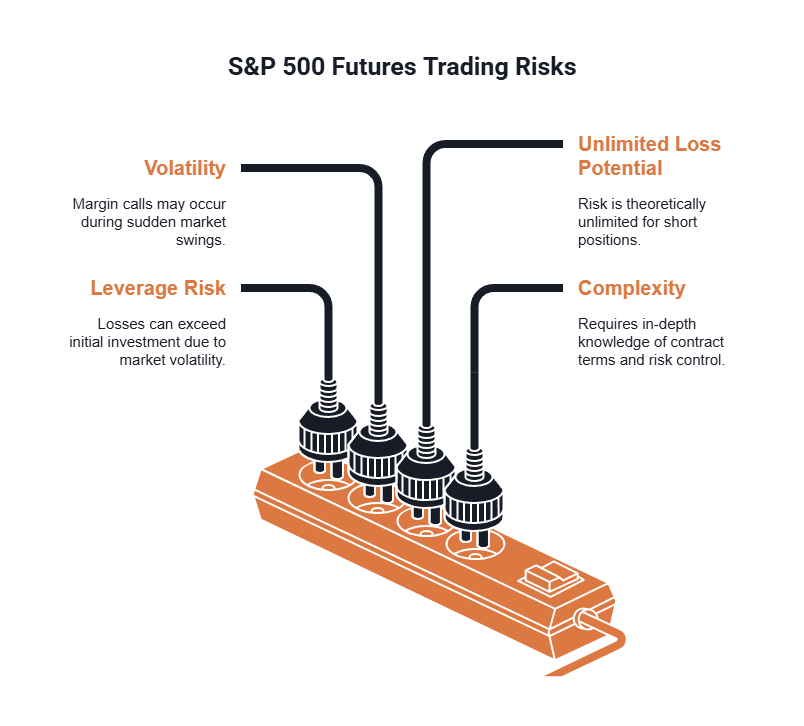S&P 500 futures have become one of the most widely used tools for investors seeking exposure to the U.S. equity market. Rather than buying hundreds of individual stocks, investors can use these contracts to speculate on the direction of the broader market, manage risk, or hedge their portfolios. Their flexibility and liquidity make them central to institutional and retail investment strategies alike. At their core, these contracts are efficient, powerful instruments — but they also carry meaningful risks.
If you’ve been pressured into making an investment you didn’t fully understand such as futures or suspect might have been fraudulent, you’re not alone—the securities fraud lawyers at Meyer Wilson Werning can help. Reach out today to discuss your next steps with us.

What Are S&P 500 Futures?
An S&P 500 futures contract is a standardized agreement to buy or sell the S&P 500 Index at a specific price on a future date. The contracts are traded on regulated exchanges, primarily the CME Group, and are cash settled, meaning no physical delivery of shares occurs. Instead, profits and losses are settled in cash based on the difference between the contract price and the actual index value at expiration.
This structure allows investors to:
- Speculate on whether the market will rise or fall.
- Hedge against losses in existing stock positions.
- Manage portfolio exposure with significantly less capital than owning the underlying securities outright.
Unlike stocks, which can be held indefinitely, futures contracts have fixed expiration dates and are generally used for short- to medium-term strategies.
We Have Recovered Over
$350 Million for Our Clients Nationwide.
Why S&P 500 Futures Matter
The S&P 500 index tracks the performance of 500 large U.S. companies across industries, making it a benchmark for institutional portfolios and mutual funds. Futures contracts tied to this index provide investors with an efficient, cost-effective way to trade or protect their exposure to the overall market.
Key Advantages of S&P 500 Futures
- Cost Efficiency – Futures allow traders to control large positions with a relatively small capital outlay through margin-based trading.
- Liquidity – S&P 500 futures are among the world’s most actively traded instruments, resulting in tight spreads and quick execution.
- Hedging Capability – Investors use them to reduce portfolio risk during volatile periods or before major market events.
- Strategic Flexibility – Investors can take long or short positions, easily adjusting market exposure without buying or selling individual stocks.
For example, if an investor anticipates a market pullback, taking a short position in S&P 500 futures can offset potential losses in an equity portfolio — effectively serving as portfolio insurance.
1. The E-mini and Micro E-mini Contracts
To make S&P 500 futures accessible to a wider range of investors, the CME Group offers both E-mini and Micro E-mini contracts.
- E-mini S&P 500 futures have a notional value equal to the S&P 500 index multiplied by $50. For instance, if the index trades at 6,000, one contract represents $300,000 (6,000 x $50). These contracts are primarily used by institutional and professional traders.
- Micro E-mini S&P 500 futures were introduced to make futures trading more accessible. With a multiplier of $5, they are one-tenth the size of an E-mini contract. Using the same index level, one Micro E-mini has a notional value of $30,000 (6,000 x $5).
Because of their smaller size, Micro E-minis require less capital and have lower margin requirements. As of late 2024, maintaining one Micro E-mini position required about $1,500, compared to approximately $15,000 for a standard E-mini contract.
This scaled structure gives both institutional and retail investors an opportunity to participate in market movements with flexibility and control.
Our lawyers are nationwide leaders in investment fraud cases.
2. Using Futures for Hedging and Capital Efficiency
Beyond speculation, one of the most important uses of S&P 500 futures is hedging — protecting a portfolio from adverse market moves. Futures let investors control a large notional position for a fraction of the capital that would otherwise be required.
A core concept in hedging with futures is beta weighting. Beta measures how sensitive a portfolio is to market movements. By aligning a portfolio’s beta with the S&P 500, an investor can estimate how much exposure they have and hedge accordingly.
Example: Hedging with a Micro E-mini Contract
Imagine an investor with a $100,000 diversified portfolio that closely tracks the S&P 500. To protect against a potential market decline, they could:
- Short two Micro E-mini contracts, posting about $3,000 in margin (approximately $1,500 per contract), to hedge roughly $60,000 in market exposure.
- If the S&P 500 drops by 100 points (around 1.7%), the futures position gains $1,000 (100 points × $5 × 2 contracts).
- That gain helps offset a similar loss in the portfolio, softening the impact of the market downturn.
Because these contracts trade nearly 24 hours a day, investors can actively adjust their hedge — increasing or reducing exposure as market conditions evolve.
We Are The firm other lawyers
call for support.
Understanding the Risks
While S&P 500 futures offer substantial benefits, they also carry significant risks. Their leverage can magnify returns, but it can just as easily magnify losses. Traders must fully understand margin requirements and risk management before entering these markets.
Key Risks to Consider:
- Leverage Risk: Losses can exceed the initial investment if the market moves sharply against a position.
- Volatility: Because futures are marked-to-market daily, margin calls may occur during sudden market swings.
- Unlimited Loss Potential: For short positions, risk is theoretically unlimited if the market surges unexpectedly.
- Complexity: Futures trading requires in-depth knowledge of contract terms, expiration cycles, and risk control strategies.
A trader shorting S&P 500 futures without stop-loss controls, for example, could face large losses in a rallying market — demonstrating how critical active monitoring and discipline are in futures trading.
Practical Applications for Investors
S&P 500 futures are widely used across different investor profiles for specific strategic goals:
- Portfolio Diversification: Gaining exposure to the entire U.S. equity market without buying multiple securities.
- Risk Management: Hedging against economic or geopolitical events that could cause volatility.
- Tactical Positioning: Taking advantage of short-term opportunities in market direction or interest rate trends.
When used responsibly, these contracts can enhance portfolio control and efficiency.
What to Take Away About S&P 500 Futures
S&P 500 futures — particularly the E-mini and Micro E-mini versions — remain essential tools for both professional traders and individual investors. They provide access to one of the most important benchmarks in global finance while offering flexibility, liquidity, and leverage.
However, these same advantages come with heightened risk. The potential for large losses means investors should approach futures trading only after developing a solid understanding of how the contracts work and how leverage amplifies both gains and losses.
At Meyer Wilson Werning, we’ve seen how mismanaged or improperly sold investment products — including derivatives and leveraged instruments — can lead to devastating losses. If you’ve suffered financial harm due to unsuitable trading strategies or advisor misconduct, contact us today so our firm can help you explore your options for recovery and accountability.
Frequently Asked Questions

What are S&P 500 futures and how do they work?
S&P 500 futures are contracts that let investors buy or sell the S&P 500 Index at a future date and price. They’re settled in cash, allowing traders to speculate on market direction or hedge portfolio risk without owning individual stocks.
What is the difference between E-mini and Micro E-mini S&P 500 futures?
E-mini contracts represent $50 times the S&P 500 Index, while Micro E-minis are one-tenth that size at $5 per point. Micro E-minis require far less capital, making them accessible to retail investors seeking smaller market exposure.
How are S&P 500 futures used for hedging?
Investors use futures to offset portfolio losses during market downturns. For example, shorting S&P 500 futures can protect long stock positions by generating gains when the market declines.
What are the main risks of trading S&P 500 futures?
The biggest risks include leverage amplification, daily margin calls, and potential for large or unlimited losses on short positions. Without careful risk management, traders can lose more than their initial investment.
Can investors lose money in S&P 500 futures even with correct market predictions?
Yes. Poor timing, margin calls, or early liquidation can turn a correct prediction into a loss. Understanding contract terms, margin rules, and volatility is critical before trading these leveraged instruments.
Recovering Losses Caused by Investment Misconduct.

